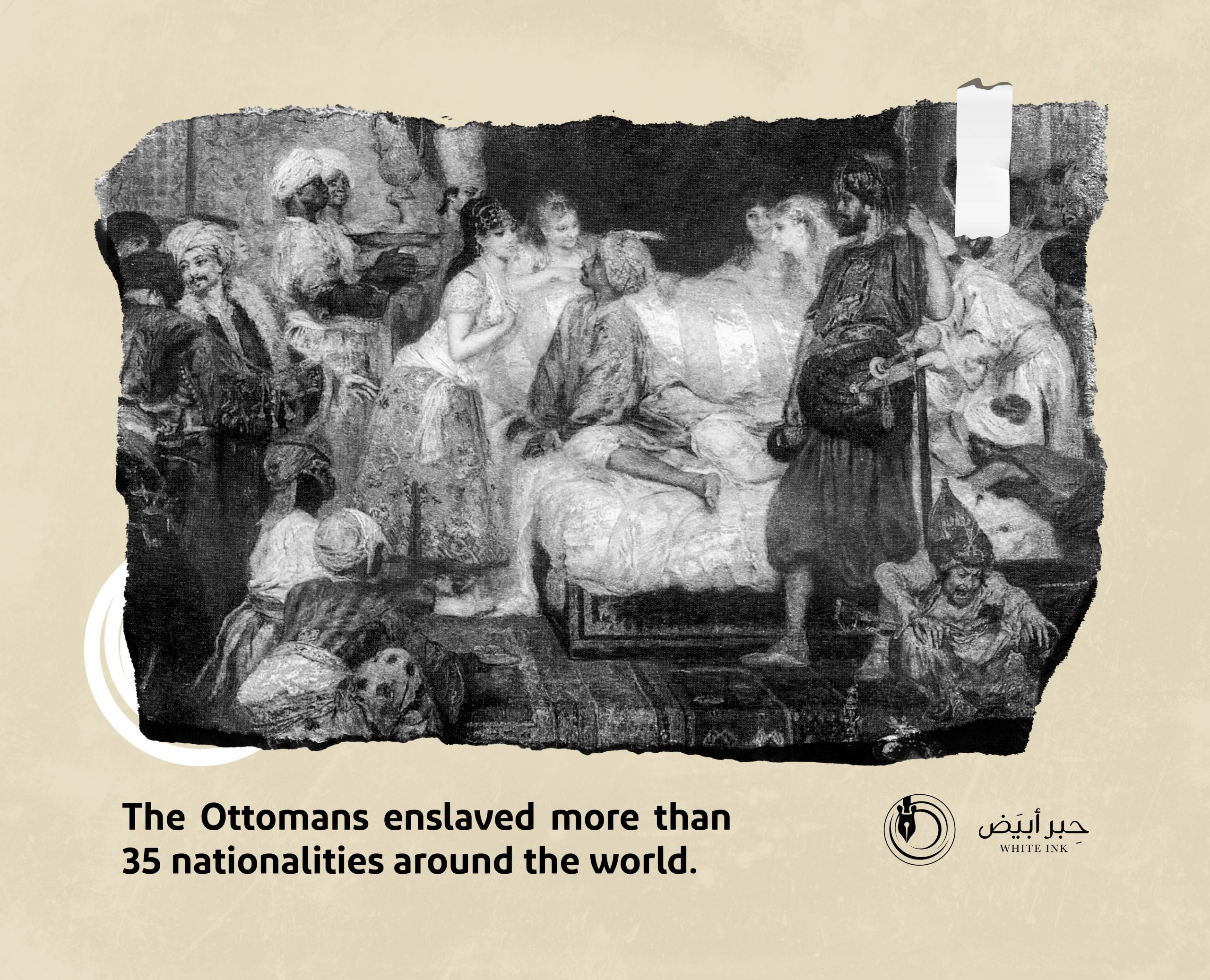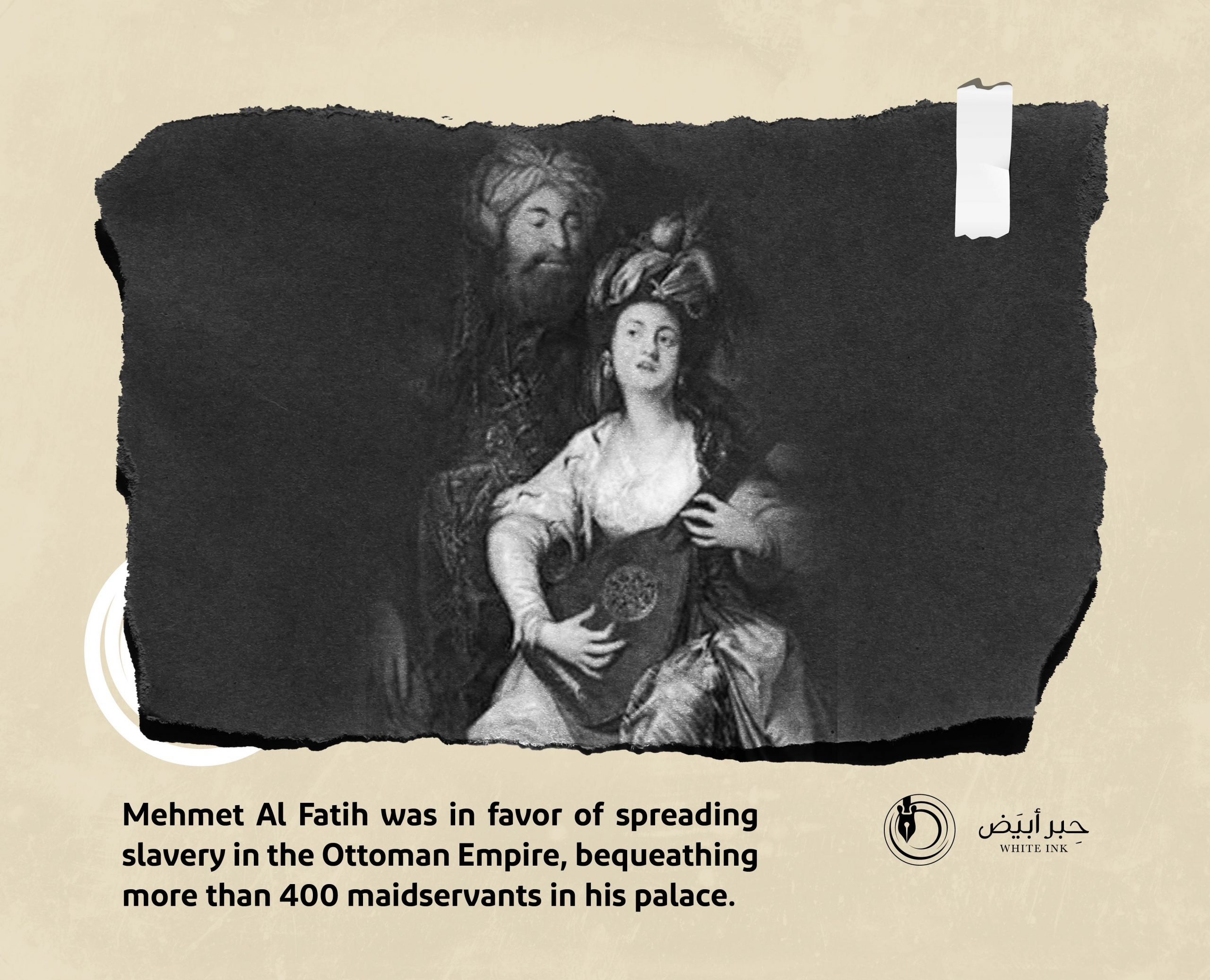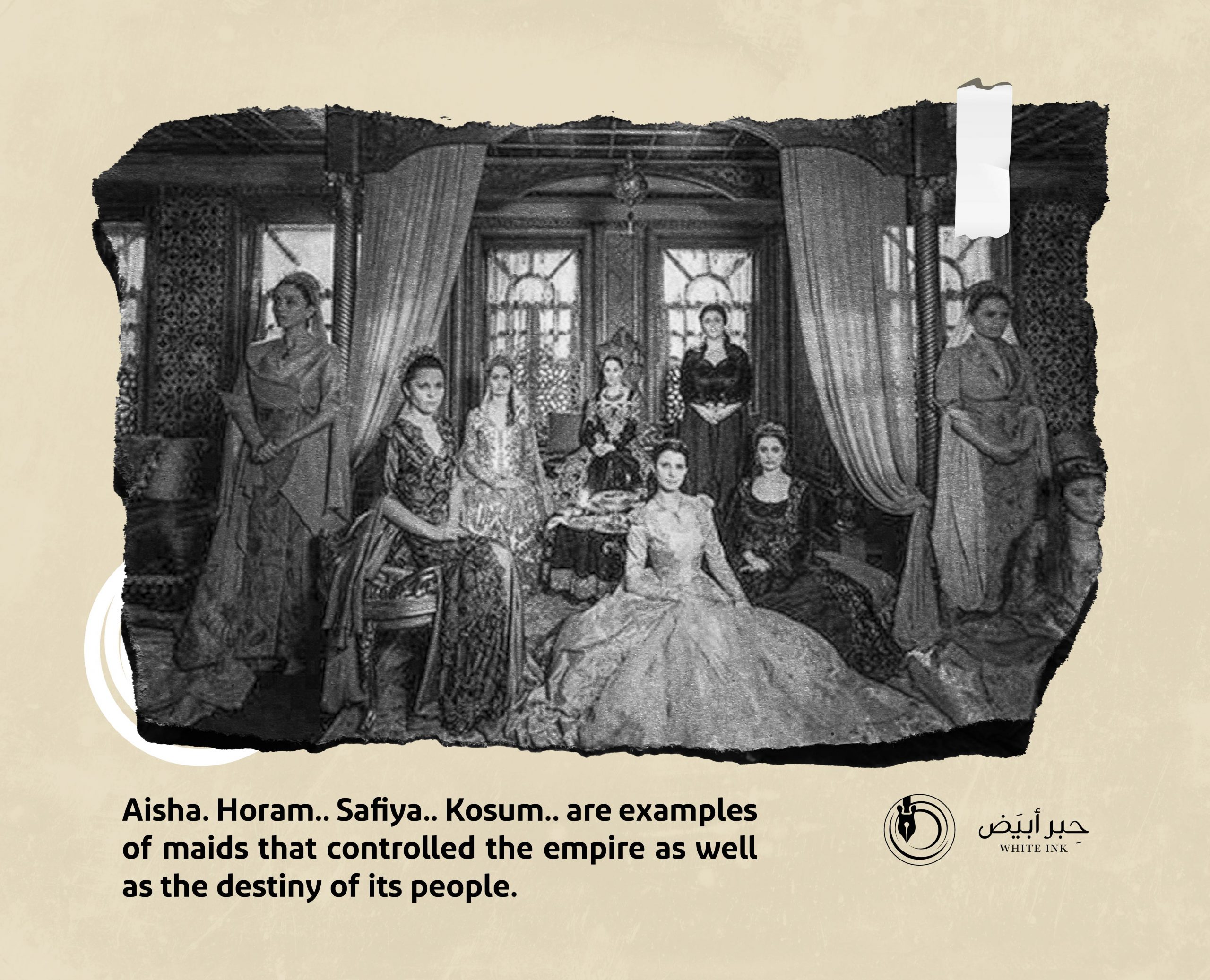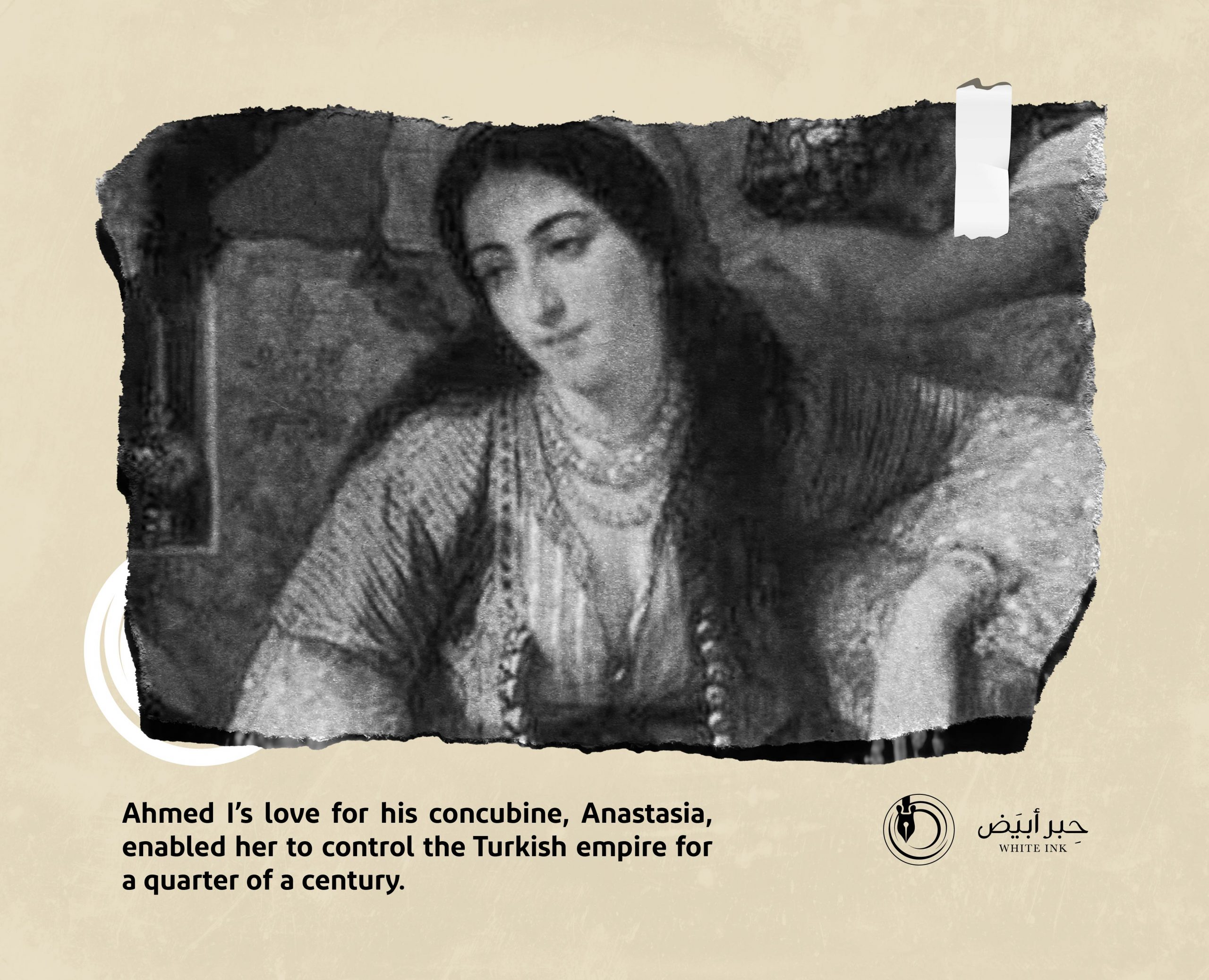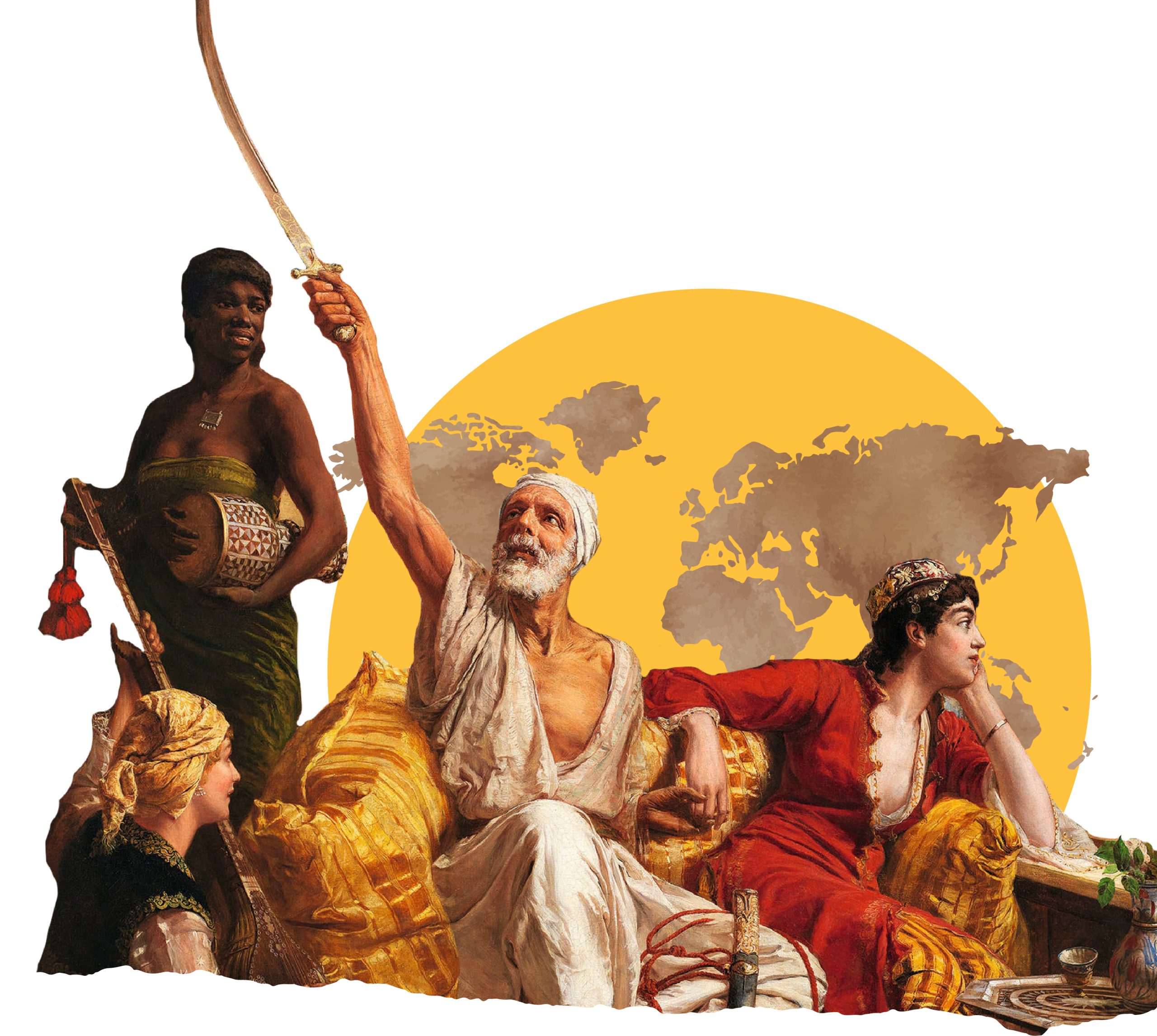
They have been forced to perform and dance…. They were exploited for entertainment, pampering and depravity.
35 nationalities
around the world were exploited as a source of maidservants for the Ottoman Palaces
Ever since they established their state, the Ottoman sultans were not ashamed to announce to everyone that their state was based on bloodshed, festivities and slavery. The Ottoman family, who claimed to rule by Islam, did not feel any unpleasant as they legalized immorality and supported depravity and spread it everywhere.
Thus, it was not surprising that the maidservants’ system became the most prominent institution of the Ottoman Empire. Since the early years of their rule, which lasted more than five centuries, during which they caused the backwardness of the Arab world, until it hit the bottom after it was at the lead; As the Turkish sultans filled their palaces with women and passing nights with singing and festivities, and the people can go to hell.
Perhaps it all started with Sultan Mehmet Al Fatih (1444-1481), who promoted the slave trade until Istanbul became a large market for slaves where the number of nationalities of maidservants reached 35 from all over the world. This led traders to be searching for maidservants with superior aesthetic features to sell them to the Ottoman family, who used to Purchase maidservants at exorbitant prices at a time when Muslims were suffering poverty and hunger under their reign.
Mehmet Al Fatih promoted the slave trade, while the sultans paid exorbitant prices to buy maidservants.

It never stopped at this point, although the main job of the maidservants is to fulfill the desires of the sultans only, and this is a matter that does not require skill or laws; the Turkish sultans were not satisfied with that, as they established a complete system for maidservants, which historians considered absurd and indicative of the extent of the obsession of the Ottoman family with women.
As for the maidservants’ system, it begins by bringing maidservants to the palaces, this process is done in more than one way, the most famous of which is captivity in wars, or kidnapping children and raising them inside the Harem, where it is designated for the women of the Turkish sultans, and the other way is to purchase from slave traders.
Some historical sources elucidate the features of upbringing system for maidservants during the reign of the Ottoman sultans. As this system begins with the entry of the maidservants to the palace, and they live in two large halls, one of which is called the great hall and the other is called the small hall. Maidservants are to be divided based on age and tendencies, and according to the hierarchical system; maidservants in that period were called “Ajamiyat” before being subjected to a strict supervision by a special supervisor called “Kakhya Kadyen”
By dint of the “Kakhya Qadin”, maidservants learn about the Ottoman protocol in addition to forcing them to learn some manual skills such as sewing and embroidery, erotic dancing, singing, playing musical instruments and how to narrate stories to amuse the Sultan.
Although maidservants were just women whose misfortune led them to serve in the palaces of the Ottoman family, but the Turkish sultans, who used to divide people, did the same with the maidservants; So, they had a hierarchical line starting from “Ajamiyat, i.e., the maidservants who recently came to the palaces, then the maidservant rises to a slightly higher position, which is Shakird, then as a Kilki and finally to Ostta, i.e. the maidservant who learned all the protocols of the Turkish sultans and is now able to teach others.
Furthermore, there was another division for the women whom the Sultan chose for his bed, and for festivities and singing, and these were called “Khasaki”. A Khasaki, who gives birth to a son to the Sultan, enjoys a special privilege, as she goes through special ceremony to kiss the hand of the Sultan while wearing the crown and sable fur; subsequently, a private suite is to be assigned to her in the court, and the first to give birth to a son to the Sultan remains at the top and is to be called “Bash Qadin”.
As for the third section, it is assigned for the maidservants who were not loved by the Sultan or undertake any work, and these are locked in their rooms and lose their lives day after day without any complain. This is considered by historians to be the cruelest prison in which a person can be imprisoned without committing any sin.
As for the other maidservants, they were no better; historical sources indicate that these women were forced to do immoral acts they could never imagine; some of them suffered from a mental disorder as a result of the depravity of the Turkish sultans and what they did inside the palaces, especially the private parties where everyone goes naked at the same time to please the Sultan. This confirms that this type of slavery was the most heinous in human history.
The English historian Bernard Lewis reveals in his book “Istanbul and the Civilization of the Islamic Caliphate”, another aspect of the life of the maidservants inside the palaces of the Ottoman family, after he traveled to Istanbul in (1599), to present a gift from Queen Elizabeth to Sultan Mehmet III.
“Louis” managed to take a peek inside through a secret window into the life of the maidservants inside the Harem, as the Ottoman sultans imposed complete secrecy on this mysterious part of the palaces and killed everyone who tried to find out what was going on inside.
“Louis” was able to peek with the help of one of the Aghas of the Harem and says that he saw about thirty girls who were playing with the ball, at first, he thought that they were males, but when he saw their hair hanging on their backs with necklaces of small pearls on, and other clear signs, he realized that they were women and describe them as beautiful.
The English historian then goes further to describe the clothes of the maidservants, saying: They wear more than one headscarf “keffiyeh” of gold cloth on their heads, and there was no tie around their necks but an exorbitant pearl necklace, a diamond hanging on the chest of each one and earrings made of diamonds, some of their shirts were of red satin, others were blue, in addition to other colors; these shirts were tied with laces – meaning a transparent piece of cloth -. As for pants, they were made of first-class cotton fabric, white as snow and thin as water, revealing the legs described by “Louis” as beautiful, and lower leg was graced by anklets.
The system of maidservants grew little by little due to the craving of the Turkish sultans for women and leaning on beds. Some historians even estimated the number of maidservants in the palace of Topkapı Saray in 1475, to be about four hundred, in addition to two hundred and fifty maidservants in another palace, all of whom belong to the sultan. Historians wondered if this was the number at a time when the Ottoman Empire and its armies were still at war, how about the number of the maidservants then, when the Turkish sultans permanently resided in their palaces; we can know where the Muslims’ money was spent if we knew that each maidservant was given a monthly allowance, in addition to Some jewels, not to mention the slaves serving these women who were also brought in with exorbitant prices.
The number of maidservants in the palace of Topkapı Sarayı reached 400 in (1475).

In conclusion, the Ottoman sultans’ greed, panting after women, and pursuing their sordid desires, cleared the path for some of the maidservants to dominate the Ottoman family, and these women took control of the reins; subsequently, the maidservants became the mothers of the sultans who ruled the Arab world after that.
Nothing can demonstrate how important the maidservants were inside the palaces, but the prominent statements mentioned by the most important Turkish historian, Halil İnalcık, who said: “As for the Harem, which is the section dedicated to the spouses of the sultans, his maidservants and his family, it was a country within the court.


- Halil İnalcık: History of the Ottoman Empire: from Origin to Decline, by: Muhammad Al-Arnaout, Beirut, 2002.
- Bernard Lewis: Istanbul and the Civilization of the Islamic Caliphate, translated by: Syed Rizwan Ali.
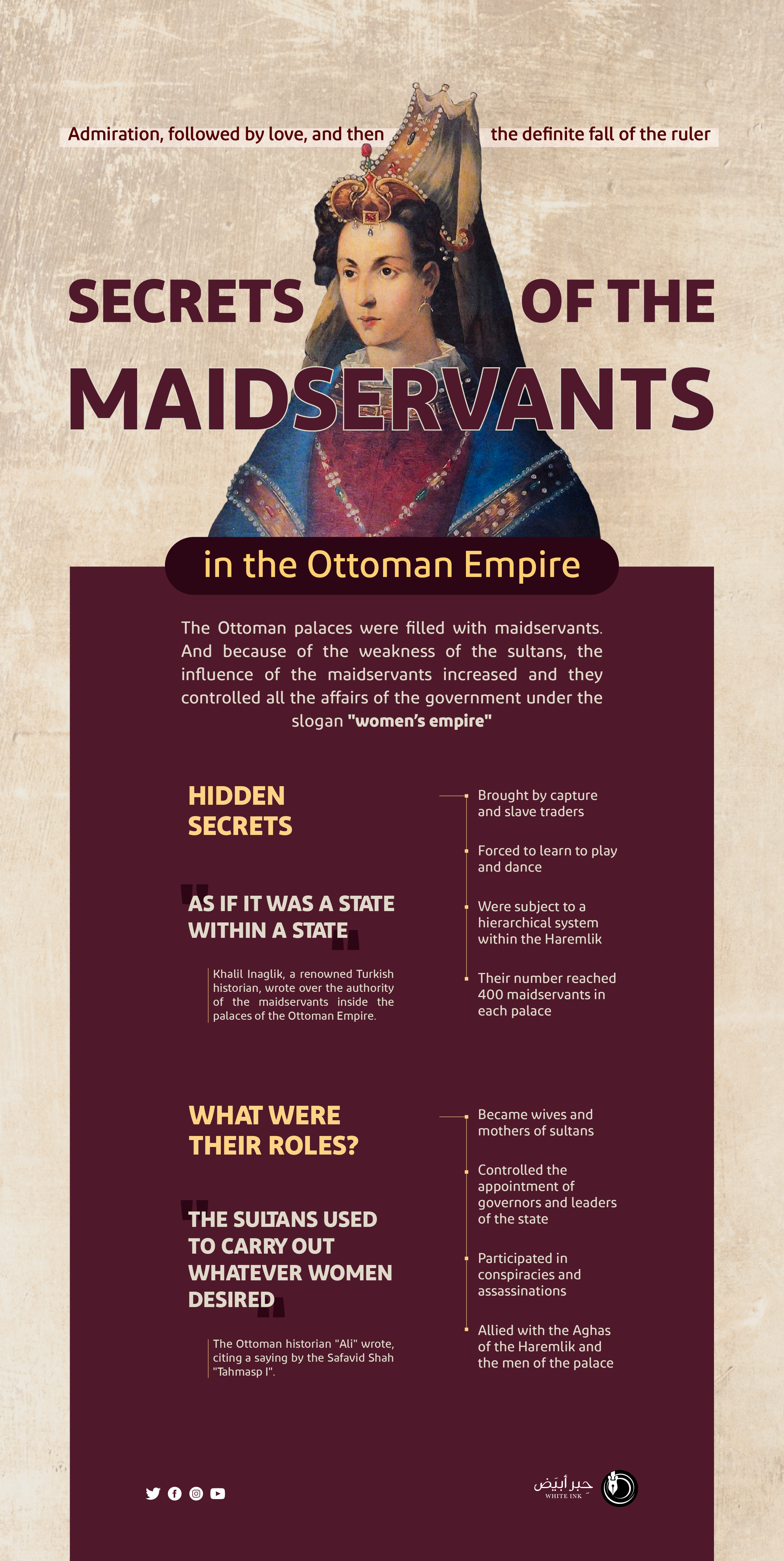
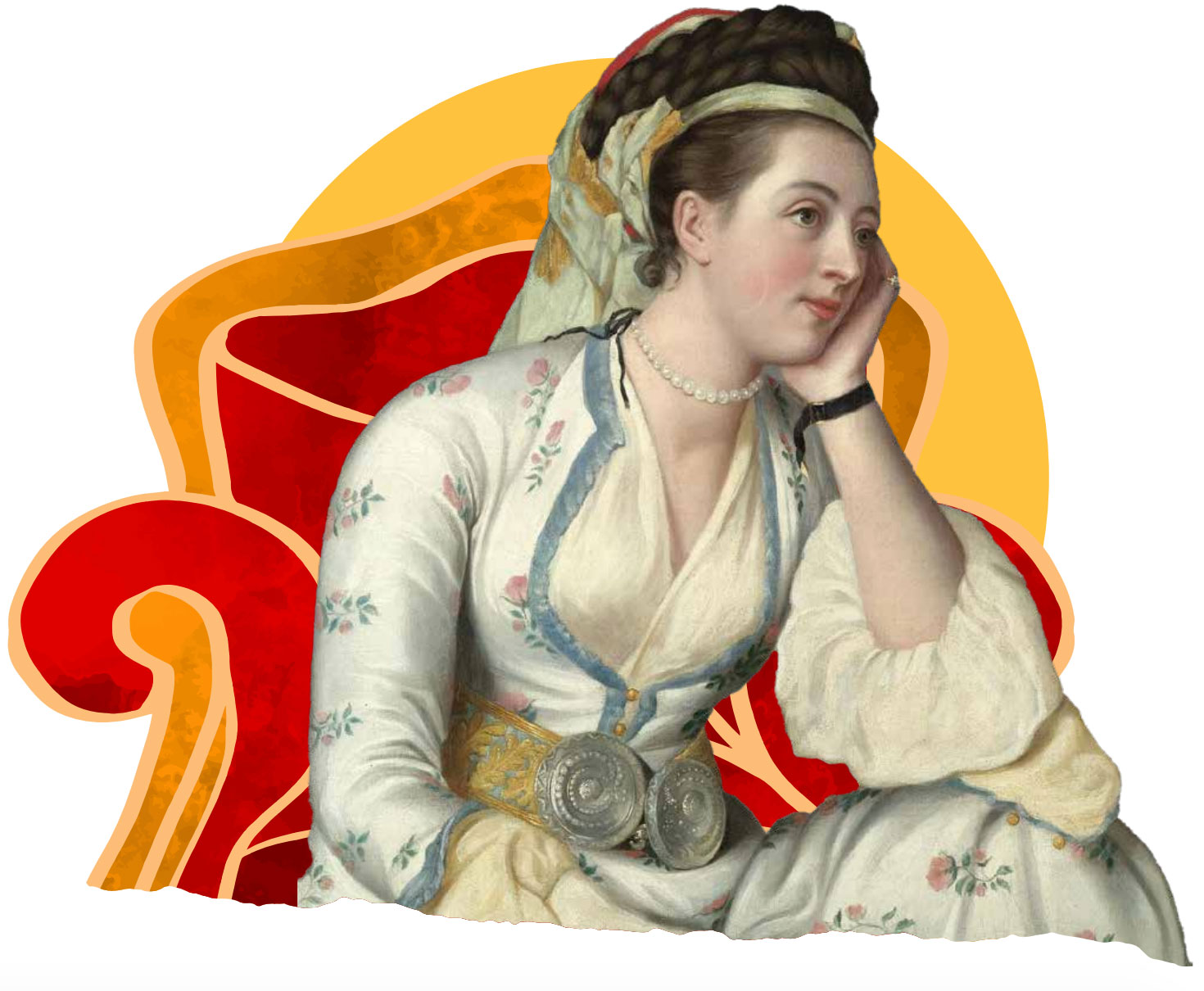
From dancing and providing pleasure
to the head of the Ottoman Empire
Maidservants who ascended to the throne of the Ottoman Empire
Under the ruling of the Ottomans, it was possible for any maidservant of unknown parentage and religion to instantly find herself sitting on the throne, controlling the lives of millions of Muslims. This is what historical sources say, which narrated how influential the maidservants were, in the era of the Ottoman Empire, and how they became mothers and wives of the Turkish sultans.
The path was almost paved, it was enough for any maidservant, who knows how to seduce the Sultan, to make him fall in love with her in order to deliver him a child, and according to the Ottoman protocols, she becomes a wife, then a mother to the next sultan, a position that gives her sovereignty and an expected advantage over the throne of the Ottoman family, then dominating the fate of millions of Muslims in the countries occupied by the Ottoman Empire.
Considering the weakness of the Turkish sultans as well, the task becomes easy, as most of the Ottomans family – according to historical sources – never panted after anything as much as women, and did nothing in their lives more than just lying in beds; some sultans never even left their palaces, in addition to the extravagance in purchasing maidservants from all over the world and being stacking them up in the Harem, where the place designated for them was in the palaces, which is something many leaders of the Ottoman Empire warned of, as many of the maidservants pretended to enter Islam and falling in love the Sultan, while in fact they are only spies for their countries of origin, which were hostile to the Ottoman Empire and to the Muslims at the same time.
However, the Ottoman sultans did not heed those warnings, as they did not really care about the parish; fulfilling their desires and lusts is what matters to them, so they expanded in purchasing maidservants and promoted slave markets; the result of which was that in 1475, there were more than 400 maidservants belonging to different nationalities, the only link, that they all were the sultan’s subjects.
According to the system that the Ottoman family set for the maidservants and the ranks within the Harem, the easiest way is for the maidservant to be loved by the sultan and deliver him a child to be the crown prince, which happened often, but it never stopped at this point, as some maidservants when they become wives due to the Turkish sultan’s weakness, they interfere in the government affairs, and some of them were actually ruling the Ottoman Empire.
Some may think that the era of maidservants’ ruling the empire started at the reign of the deterioration of the Ottoman Empire; in fact, this started early, as historical sources indicate that the phenomenon of the rule of the “harem” of the Ottoman Empire began with Sultan Selim I (1512-1520) AD, as he was a dictator and a bloodthirst; his mother, Sultana Aisha, was the first ruler of the palace, as the mother of the Sultan, and she was the first to take this position, and she played important roles during the reign of her son until her death. Perhaps the most prominent feature of Sultana Aisha is that she put down the conflict of Selim I’s wives, a conflict that could have led to the assassination of the Sultan himself in order for each wife to ensure that her son would be the crown prince, which is a common occurrence since the establishment of the Ottoman Empire, and how many brothers were killed without guilt by the hands of their brothers or their sons.
Sultana Aisha, the mother of Selim I, the first maidservant who interfered in the government affairs.

As for Suleiman the Magnificent, who ruled in (1520-1566) AD, it was rumored that he was the most strict and powerful of the Turkish sultans, as historical narrations reveal that Roxelana was the mastermind behind most of the decisions he took, a maidservant of Ukrainian-Armenian origins whose original name is “Alexandra Ilyovska”, and belongs to a Christian father, she was captured at the age of fourteen, and sold in the slave market to Ottoman traders until she reached the Palace; there, she was able to take Suleiman the Magnificent mind away, who loved her, and fell in front of her beauty, so he left his army’s military campaigns and sat writing poems next to her.
Roxelana managed to deliver children to Suleiman the Magnificent (Abdullah, Selim, Bayezid) to become the wife of the sultan and the mother of the next sultan, but Roxelana’s role did not stop to this point, to ensure that her children make it to the throne, she began to play political roles to be the first lady in this field; which were not honorable, but based on killing and intrigues, as usual among the Ottoman family. Roxelana managed to incite Suleiman the Magnificent to kill the Greatest Vizier, Ibrahim Pasha, who was against the intervention of the Sultan’s wife in everything.
Suleiman the Magnificent fell in love with the European Roxelana, who incited him to kill his son.

Roxelana also managed to incite Suleiman the Magnificent assassinate his son Mustafa from his other wife, “Mahi Duran Gilhar Sultan”, which made the Ottoman historian Minejm Bashi in his book “Jami al-Dawla” to say that Roxelana was the origin of the women’s deception in the palaces; so, she was able to eliminate Mustafa bin Suleiman the Magnificent in 1553 AD, the Janissary soldiers extremely grieved due to this incident; Sultan Suleiman the Magnificent was not spared criticism.
Historical sources stated that what Roxelana did, was not unique; Arguably, she established a political doctrine, followed by the sultans of the Turks thereafter, and Selim II (1566-1574) AD, the son of Suleiman the Magnificent was not better than his father; immediately, after Selim II took over the throne, he fell in love with Nurbanu, a maidservant originally from Venice, who was born on the island of Paros in the Mediterranean, and her real name was “Cecilia”. She entered the palaces of Ottoman family when she was eleven years old and she was loved by Prince Selim II, then she gave birth to Prince Murad, thus she was elevated to the rank of “Khasaki”, i.e., the mother of the prince.
Historians call the period of Selim II the era of the Harem Sultanate because of the maidservant Nurbanu.

As soon as Selim II became the Sultan of the Ottoman Empire, Nurbanu dominated the throne; such wonder will wear off, when we know that Selim II was the first Ottoman sultan to slack in his palaces and neglect the matter of his subjects and securing the borders of his country, which prompted Nurbanu to play a greater role, so she controlled the appointments of leaders and the Grand Vizier, and established alliances with some of the Aghas of the Harem.
With Murad III ascending to the throne (1574-1595) AD, Nurbanu’s interference in the government affairs increased in a way that prompted historians to call the reign of Murad III the Sultanate of Women and the Courtier, as the real power transferred to the Harem and fell in Nurbanu’s hands.
Sophia Beluji, whom Murad III fell in love with and gave him their son, Sultan Muhammad, was the only maidservant who managed to overthrow Sultana Nurbanu. Throw such way, that maidservant became Sultana Safiya, the wife of the Sultan and the mother of a crown prince.
The path for Safiya Sultan to the throne was not paved, as the mother of Murad III, Nurbanu, was also still the ruler of the palaces, so she tempted her son with other maidservants to keep him away from Safiya; But Sultan Murad III could not, as he fell in love with Safiya.
Many secret battles, between the wife and the mother of the sultan, took place in the palace during the rule of Murad III, but Safiya, with many alliances with the Aghas of the Harem, managed to settle the conflict in her favor, as she paved the way for her son to take over. While Murad III was on his deathbed, Safiya assassinated all of his sons, who were 18, to be called the bloodthirst.
Safiya Sultan’s role continued after taking control, during the reign of her son Muhammad III (1595-1603) AD, it even expanded to become responsible for the appointments of ministers and governors; only the death of her son Muhammad III in 1603 AD restricted her power.
A woman who controlled three Turkish sultans, during four decades approximately; this is what the policy of the Ottoman Empire led to, whose leaders Let the reins in the hands of the maidservants, the same applied to Kösem Sultan, the wife of Sultan Ahmed I (1603-1617 AD), who entirely participated in the Government affairs during her husband’s reign and she became the most famous lady of the Ottoman Empire due to her going role and appointment of leaders, in addition to controlling the movement of promotions during the reign of her son Murad IV (1623-1640) AD, and then through her grandson Muhammad IV (1648-1687) AD.
This Ottoman policy, in which they left the reins to the maidservants, had a direct impact on Muslims and the conditions of the parish during the reign of the Turkish sultans. As historical sources elucidate that during the period between the death of Sultan Suleiman the Magnificent and the accession of Sultan Mustafa IV to the throne in 1907 AD, eighteen sultans ruled, a large number caused by the rule struggles led by the maidservants, which led to the killing of a large number of the Ottoman family.
Also, as a result of the maidservants’ domination over the throne of the Ottoman Empire, corruption appeared in the government, and deepened due to the alliances of some women with men in the palace. Therefore, it was not surprising that the periods that witnessed the emergence of women in power were the periods that witnessed the weakness of the Ottoman Empire, and the increase in independence tendencies; In addition to the aggression of Western foreign countries against it.
In conclusion, only the people, who suffered from poverty, hunger and insecurity in their country, paid the price; as a result of the sultans being sluggish in their palaces and let ruling played right into maidservants’ hands.
The increasing role of maidservants was the main reason for the deterioration of the Ottoman Empire and the aggression of the West against it.



- İlber Ortaylı, The Ottomans, the Last Empires, translated by: Abdelkader Abdelli (Beirut: Arab Scientific Publishers, INC 2015 AD)
- Halil İnalcık: History of the Ottoman Empire: from Origin to Decline, by: Muhammad Al-Arnaout (Beirut: Dar Al-Madar Al-Islami, 2002).
- Abdel Rahim Benhada, The Ottomans, Institutions, Economy and Culture, (Casablanca: Sebou Telecom, 2008).
- Fereidun Amjan, Suleiman the Magnificent Sultan of Albrain Bahrain, Facts in the Light Sources, translated by: Gamal, Farouk and another (Cairo: Nile for Publishing and Distribution, 2014 AD).
- Mohamed Ahmed Althagafi, Marriage Ottoman sultans of foreign women and its impact on weakening the state (Makkah Al-Mukarramah: Master’s Thesis, Department of Higher Historical and Civilization Studies, Umm Al-Qura University, 2012).
- Mohammed Suhail Taqqosh, The History of the Ottomans from the State to the overthrow of the Caliphate, (Beirut: Dar An-nafaes for Printing, Publishing and Distribution, 2nd Edition, 2008 AD).
- Munejjim Bashi Ahmed dede, Jami’ Al-Dawwal, investigation by: Ghassan Ali Al-Rimal, (Makkah: PhD thesis, Department of Higher Historical and Civilization Studies, Umm Al-Qura University, 1997).
- Ismail Ahmed: The Ottoman Empire in Modern Islamic History. Obeikan Store. page. 93-94.
- Kamal al-Din Ihsan: The Ottoman Empire, History and Civilization (Saleh Saadawi). P1. 1999.
- Lewis, Bernard: Istanbul and the Civilization of the Islamic Caliphate. (Syed Rizwan Ali). (1982). i 2. saudi-publishing-and-distribution-house. p. 105.
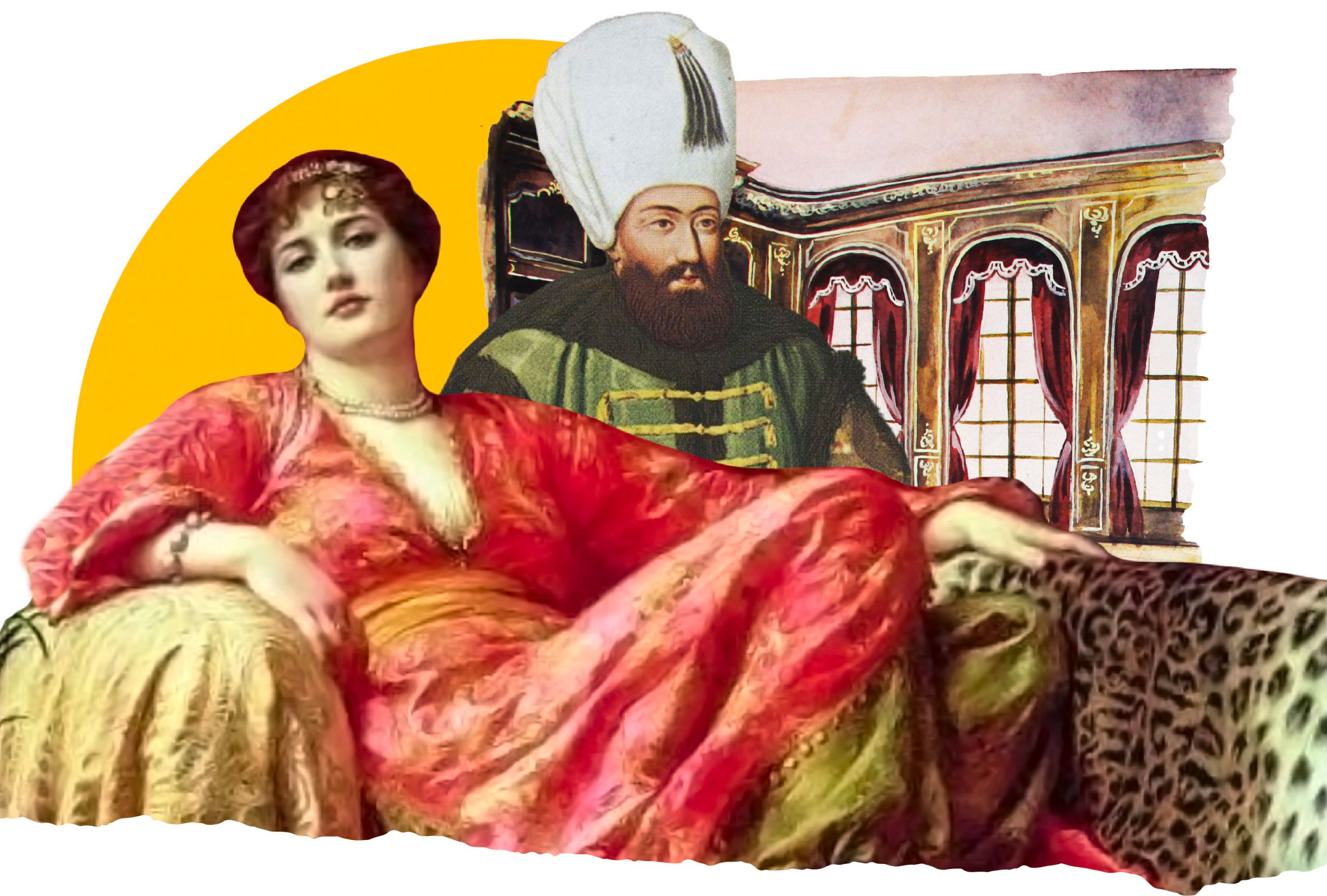
Ahmed I fell in love with her, and she ruled the Ottoman Empire for a quarter of a century
Anastasia, the Maidservant, and the Lover Sultan
How can love be considered as an exception, and that a man falling in love with a woman is an event that deserves to be tackled by historians in order to reveal the side scenes and record the events as if they have found a precious treasure!
However, in fact, the astonishment will fade if the one who fell in love is an Ottoman sultan. The presence of someone, who realizes the value of love, among The Ottomans who professionally shed blood; enslaved all women, men, and children; and encouraged immorality as well as dissoluteness is a precious treasure that deserves all this. Nevertheless, the hero of the love story has quickly gone as if the palaces of the Turkish sultans cannot bear to witness any noble sentiment.
The hero of the most famous love story was Sultan Ahmed I (1590- 1617) AD. The man was a little different from his grandparents and his fathers. On one hand, as clarified by the historical narratives, Sultan Ahmed I was a leading figure, however, in any case he was a dictator who unilaterally made Ottoman political decisions. This has led to some kind of calmness during his reign, especially after he has succeeded to impose constitutional custom that stated to give power to the elder and most wise crown prince. This happened after Turkish sultans have left power to the strongest men what resulted in massacres among brothers. Nevertheless, what Sultan Ahmed I has done did not last long after his death.
Sultan Ahmed I was also different from his grandparents regarding his view of Harem, which refers to domestic spaces reserved for maidservants and wives of Turkish sultans. He was the least one interested in it but this does not mean that he was indifferent to women as clarified by historical resources. Sultan Ahmed I was worried because Harem role became deep rooted in Ottoman Empire until it became the actual headquarter of ruling.
However, irony, perhaps the requirements of legendry love stories, was that the man who had that vision which was somewhat correct was the same man who fell in love with Anastasia, the maidservant, who was born in Greece, specifically in the Island of Tinos to a Christian family. Her father was an orthodox monk. Since her childhood, Anastasia had great beauty which drew the attention of Bosnia governor who purchased her from a person named Mr. Biller. Then, he sent her to the Sublime Porte in Istanbul as a kind of courtesy towards Turkish sultans who were very pleased with these presents.
The little girl did not realize anything inside “Topkapi” Palace where she settled in the beginning. Everything around her was luxurious and frightening. Every door hid secrets behind which were difficult to know. In the midst of all this, a young man saw her for the first time. He was Prince Ahmed who could not believe that there was such utmost beauty. He soon included her within his women and changed her name to be “Mahpeyker” which literally meant “Moon Face”.
Until that moment, Moon Face was merely a maidservant who mesmerize the prince. Nevertheless, the man who was worried about the increasing role of Harem became fond of going there to see her and listen to her talks and stories. One of the basics of raising maidservants was to teach them storytelling in order to entertain Turkish sultans. Prince Ahmed shortly fell in love with Anastasia, then, he became the talk of the ruling palaces and the jesting entertainment of women inside Harem rooms.
The British historian, Philip Mansell, mentioned a description in his book “Constantinople – City of the World’s Desire” that Sultan Ahmed I was obsessed with the love of his maidservant, Anastasia; in spite of the available temptations and the pressure of his mother “Handan” to leave her, especially that the Sultan was married to Mahfairouz who died in early age in mysterious circumstances.
The lover Sultan did not care about any pressures. He kept following his heart that was attached to the Moon Face. She became his moon and sun. He stayed in Harem for days, as he did not want to leave her. The matter shortly ended when Anastasia declared that she converted to Islam, then, she married Prince Ahmed who became Sultan and she became Sultana.
Although historical narratives indicate that Sultan Ahmed I was sincere in his love and that he was one of the few Turkish sultans who had genuine love relationships, other historical resources clarify that Anastasia, whose name became “Kosem” after she had married the Sultan, was not that innocent. Turkish historian, Yilmaz Öztuna, described Kosem as an exceptionally clever woman. However, she was also cunning, evasive, and she mastered making multifaceted political plans and conspiracies. She was also influential with persuasive talk. She has placated the people a lot to achieve her ambitions.
On the part of Anastasia, it was not pure love but she has won the heart of the Ottoman Sultan Ahmed I according to historians due to two advantages which were the glamorous beauty and her sensibleness. It is rarely to find one woman endowed with such qualities inside Harem of Ottoman palaces. The French historian, Madeleine Angélique Poisson (1684- 1770 AD), described the love story in her book titled “Anecdotes or Secret History of the House of Ottoman” saying that it was more like an affection that brought together two children who grew up and were raised together.
The beautiful charming woman was distinguished by cunning, slyness, as well as making political plans and intrigues.

Kosem gave birth, from Ahmed I, to Murad IV who took the Ottoman throne later. However, until 1617 AD, the role of Kosem Sultan regarding the government affairs was only advice and intervening in the state affairs within limits. In the palace of Ottoman rule, she was still the beloved woman, and wife of Sultan. She was the mother of Sultan’s crown prince, as well.
However, in 1617 AD, Sultan Ahmed I died at the age of twenty- seven. Upon his departure, Kosem was preparing for another more powerful role. That role made her sit on the throne of Ottoman Empire for a quarter of a century through which she could unprecedentedly clutch all the ruling affairs.
The beloved woman quickly changed her face. Since she entered the ruling palace, she was ignorant of its features until she became the Valid Sultan, which was the most important position inside the Ottoman Empire according to the Ottoman protocols. Kosem did not lack any skill. As soon as Murad IV, her son, took the power (1623- 1640 AD), she started making strong relationships with the most important departments of Ottoman Empire topped by the department of Grand Vizier and Sheikh Al- Islam, as well as Aghas lobby. If anyone opposed her, she incited Sultan Murad IV against him to remove him from his position. Little by little, those who aspired to positions knew that the starting point is Kosem Sultan. Thus, she had the most important leaders of Ottoman Empire in her hands who owed her allegiance.
She has ruled the Ottoman Empire for a quarter of a century during the era of her two sons and grandson.

On the other hand, Kosem Sultan worked to create a popular base for her through charity foundations on which she spent some of her money. With regard to the money of Kosem Sultan, some historians indicate that she has amassed fortune that exceeded that of the Pashas of Ottoman Empire. She seized so many lands. When she died, all this money has gone to the treasury of Ottoman Empire.
That was the case until the death of Murad IV whose official deputy was Kosem Sultan. She also continued her route during the reign of her second son, Ibrahim I (1640- 1648 AD).
However, things changed a little when her grandson, Mohammed IV, took power (1648- 1687 AD). At the time when Kosem Sultan was still controlling everything in the Ottoman Empire from appointing governors to Grand Vizier, and sometimes she controlled sending military campaigns, there was a new Sultana. She was Khadija Tarkhan, the mother of Sultan Mohammed IV.
In order to show the character of Kosem Sultan, the gentle mistress who became the sole ruler of everything, Kosem Sultan decided to assassinate her grandson, Mohammed IV, because his mother Khadija Tarkhan was not friendly to her, unlike the mother of her other grandson, Suleiman, whom she wanted to take the power after killing Mohammed IV.
Such heinous crimes from a grandmother to her grandson was not something strange to the palaces of the Ottomans which witnessed the massacres of brothers against brothers, and of fathers against sons. For the sake of the throne, any life can be taken.
Khadija Tarkhan, the mother of Sultan Mohammed IV, knew what Kosem was thinking of, so she preempted the matter as she used her influence to persuade the head of Harem Aghas to assassinate Kosem Sultan. That was what actually happened on Sep. 4, 1651 AD when slaves entered the ward of Kosem Sultan. They executed her by strangulation when she was at the age of 62. She was buried beside the tomb of her husband, Sultan Ahmed I, in a region called “Sultan Ahmed”.
Khadija Tarkhan plotted the assignation of Anastasia due to the rule conflict.



- Abdulaziz Mohammed Al- Shinawy “Ottoman Empire: an Islamic Maligned State”, Anglo-Egyptian Bookshop, Cairo 1980 AD
- Yilmaz Öztuna “History of the Ottoman State”, Faisal Finance Corporate, Turkey 1408 Ah/ 1988 AD
- Philip Mansell, “Constantinople – City of the World’s Desire”, translated by Dr. Mustafa Muhammad Qasim, World of Knowledge, Kuwait 2015 AD.
- Madame de Gomez (Madeleine Angélique Poisson) “Anecdotes or Secret History of the House of Ottoman” (1724 AD edition), France, July 2020 AD.


